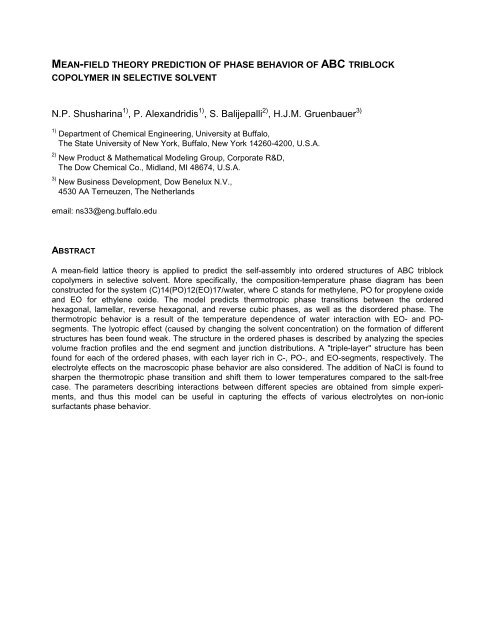Collapse of polymer brushes grafted onto planar ... - Wageningen UR
Collapse of polymer brushes grafted onto planar ... - Wageningen UR
Collapse of polymer brushes grafted onto planar ... - Wageningen UR
You also want an ePaper? Increase the reach of your titles
YUMPU automatically turns print PDFs into web optimized ePapers that Google loves.
MEAN-FIELD THEORY PREDICTION OF PHASE BEHAVIOR OF ABC TRIBLOCK<br />
COPOLYMER IN SELECTIVE SOLVENT<br />
N.P. Shusharina 1) , P. Alexandridis 1) , S. Balijepalli 2) , H.J.M. Gruenbauer 3)<br />
1) Department <strong>of</strong> Chemical Engineering, University at Buffalo,<br />
The State University <strong>of</strong> New York, Buffalo, New York 14260-4200, U.S.A.<br />
2) New Product & Mathematical Modeling Group, Corporate R&D,<br />
The Dow Chemical Co., Midland, MI 48674, U.S.A.<br />
3) New Business Development, Dow Benelux N.V.,<br />
4530 AA Terneuzen, The Netherlands<br />
email: ns33@eng.buffalo.edu<br />
ABSTRACT<br />
A mean-field lattice theory is applied to predict the self-assembly into ordered structures <strong>of</strong> ABC triblock<br />
co<strong>polymer</strong>s in selective solvent. More specifically, the composition-temperature phase diagram has been<br />
constructed for the system (C)14(PO)12(EO)17/water, where C stands for methylene, PO for propylene oxide<br />
and EO for ethylene oxide. The model predicts thermotropic phase transitions between the ordered<br />
hexagonal, lamellar, reverse hexagonal, and reverse cubic phases, as well as the disordered phase. The<br />
thermotropic behavior is a result <strong>of</strong> the temperature dependence <strong>of</strong> water interaction with EO- and POsegments.<br />
The lyotropic effect (caused by changing the solvent concentration) on the formation <strong>of</strong> different<br />
structures has been found weak. The structure in the ordered phases is described by analyzing the species<br />
volume fraction pr<strong>of</strong>iles and the end segment and junction distributions. A "triple-layer" structure has been<br />
found for each <strong>of</strong> the ordered phases, with each layer rich in C-, PO-, and EO-segments, respectively. The<br />
electrolyte effects on the macroscopic phase behavior are also considered. The addition <strong>of</strong> NaCl is found to<br />
sharpen the thermotropic phase transition and shift them to lower temperatures compared to the salt-free<br />
case. The parameters describing interactions between different species are obtained from simple experiments,<br />
and thus this model can be useful in capturing the effects <strong>of</strong> various electrolytes on non-ionic<br />
surfactants phase behavior.

















